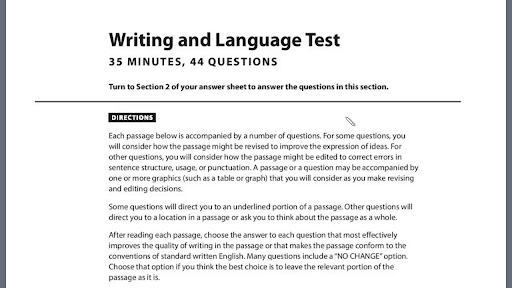As stated in “Preparing for and Understanding the SAT: Part One,” the SAT has both  “English” and “Math.” Of the “English section, there are three parts: Reading; Writing and Language; and Essay. The essay is optional. We will address the other two sections here.
“English” and “Math.” Of the “English section, there are three parts: Reading; Writing and Language; and Essay. The essay is optional. We will address the other two sections here.
Reading Test
The Reading Test is made up of 52 questions with 65 minutes to complete it. It’s essential that students practice and prepare for the test. Students will also do better if familiar with the test format and directions. Reading the instructions and understanding them now will save valuable time during the SAT:
65 MINUTES, 52 QUESTIONS

The Reading Test is made up of reading passages from different subject areas:
- One passage on US & World Literature: selection of fiction
- Two passages on History & Social Studies: selections from fields such as economics, sociology, and political science
- Two passages on Science: deal with information, concepts, and experiments in the fields of Earth science, biology, chemistry, and physics
This helps keep the playing field level–some people are strong readers of science while others better comprehend fiction readings.
The Reading Test has two unique features to be aware of:
- Paired passages: a pair of related passages that are on the same topic and interact with one another in some way. For example, the passages might represent two opposing viewpoints on a topic.
- Informational graphics: Some passages include tables, graphs, or charts that correspond to the topic of the passage.
Before taking the Reading Test, keep some of these tips in mind:
- Determine the main ideas of the passage (What’s the point?)
- Understand the sequences of events
- Comprehend the cause-effect relationships
- Analyze the author’s or narrator’s voice and purpose
- If you know you’ll have time, look at the questions first
- Read it once; there is no need to re-read unless your answering a question about a specific quote
- Make notes as you read – look at tone, bias, main idea, subjects, and language used
Then, when you read, consider following these four steps:
- If you know you’ll have time, look at the questions first. The questions might mention key details (characters, events, etc.), so make note to look for those in the text when you read.
- Read the passage once; get the tones and attitude of text; get the main idea of the text.
- Make notes as you read.
- Chances are you can re-read a paragraph, but don’t re-read the text.
Writing and Language Test
As stated before, it’s important to practice the test and to know the instructions before going into the test in order to save important and much-needed time:

The Writing and Language Test is made up of four passages. These include non-fiction, informative/explanatory, and argumentative texts. Next to the passages, there are questions. Each passage has 11 questions.
When looking at the passages, consider the following:
- Macro Logic: How the sentences and paragraphs fit together.
- Transitional Logic: How to connect different thoughts together.
- Relevance: Determine whether a sentence fits in.
- Author Intent: Understand the point of the author and writing techniques.
- Formality and Tone
When working through this section, remember that everything not underlined is taken as fact; everything underlined is under question. Read through the passage quickly before looking at questions, and don’t worry about looking for errors. Next, read the questions, and look over surrounding sentences for context.
As you work through the parts under question, ask yourself the following:
-
- Does this sentence contribute to the topic? Is it new information or is it simply rephrasing the same information? The SAT hates redundancy!
- Is the style and tone consistent with the rest of the passage? Does the underlined portion fit the author’s voice?
- Do the paragraphs transition well and are they consistent with the others?
When looking at parts under questions, there are some common mistakes that the SAT tests. Some of it seems too easy to be on such an important test, but it’s actually quite easy to overlook these common mistakes when not paying close attention. So, students should be on the look out for these:
- Effect vs affect
- A lot vs allot vs a lot
- into (movement) vs in to (I came in to get a drink)
- then (shift in time) vs than (comparison)
- assure (promise) vs insure (protect risk) vs ensure (to make certain)
- less (can’t count) vs fewer (can count)
- between (two things, clearly separated) vs among (several things, not clearly separated)
- me (you are the object receiving the action–“Please contact me”) vs myself (reflexive pronoun—“I hit myself”)
In the past, students spent weeks studying “SAT words” with notecards. The new format of the SAT covers much more territory and is not as limited, saving students the dreadful memorization of definition after definition. However, knowing a few prefixes can help the student understand the words in the test by their context. Here are a few common ones to be familiar with:
omni – all – omnipotent, omnipresent, omnivore
inter – between – intercede, interfere, interject
intra – within – intrapersonal, intramural
mal – bad – maladjusted, malign
ben – good – benevolent, benefit
grat – pleasing – gratify, gratuity
sub – below – subzero, substitute, subordinate
re – again – realign, readjust
retro – back – retroact (act backward)
se – apart – secession (withdraw from assoc.), secret (kept apart/hidden), select (choose one, set apart)
dys – bad/abnormal – dystopia, dysfunction
sym – together – symbol (bring meanings together)
super – above – supersede (take the place of previous supervisor), superfluous (more than needed)

 The “who” is doing the verb, hitting. Now, let’s say I did the hitting but I don’t know who I hit:
The “who” is doing the verb, hitting. Now, let’s say I did the hitting but I don’t know who I hit: